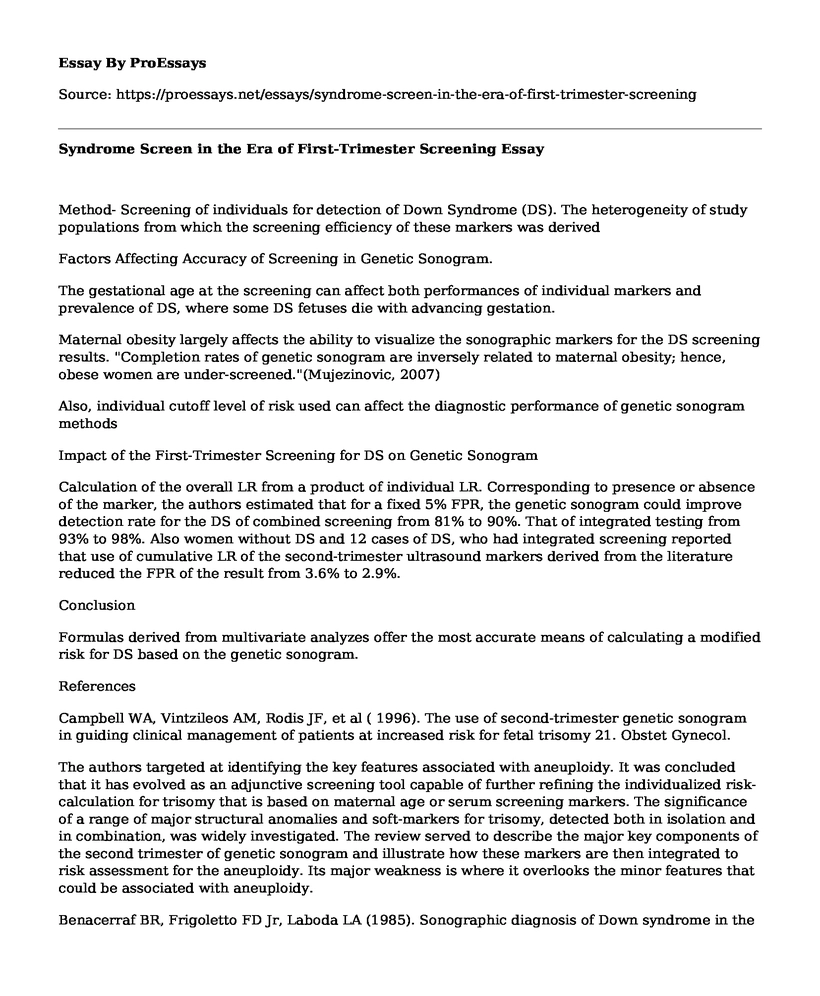Method- Screening of individuals for detection of Down Syndrome (DS). The heterogeneity of study populations from which the screening efficiency of these markers was derived
Factors Affecting Accuracy of Screening in Genetic Sonogram.
The gestational age at the screening can affect both performances of individual markers and prevalence of DS, where some DS fetuses die with advancing gestation.
Maternal obesity largely affects the ability to visualize the sonographic markers for the DS screening results. "Completion rates of genetic sonogram are inversely related to maternal obesity; hence, obese women are under-screened."(Mujezinovic, 2007)
Also, individual cutoff level of risk used can affect the diagnostic performance of genetic sonogram methods
Impact of the First-Trimester Screening for DS on Genetic Sonogram
Calculation of the overall LR from a product of individual LR. Corresponding to presence or absence of the marker, the authors estimated that for a fixed 5% FPR, the genetic sonogram could improve detection rate for the DS of combined screening from 81% to 90%. That of integrated testing from 93% to 98%. Also women without DS and 12 cases of DS, who had integrated screening reported that use of cumulative LR of the second-trimester ultrasound markers derived from the literature reduced the FPR of the result from 3.6% to 2.9%.
Conclusion
Formulas derived from multivariate analyzes offer the most accurate means of calculating a modified risk for DS based on the genetic sonogram.
References
Campbell WA, Vintzileos AM, Rodis JF, et al ( 1996). The use of second-trimester genetic sonogram in guiding clinical management of patients at increased risk for fetal trisomy 21. Obstet Gynecol.
The authors targeted at identifying the key features associated with aneuploidy. It was concluded that it has evolved as an adjunctive screening tool capable of further refining the individualized risk-calculation for trisomy that is based on maternal age or serum screening markers. The significance of a range of major structural anomalies and soft-markers for trisomy, detected both in isolation and in combination, was widely investigated. The review served to describe the major key components of the second trimester of genetic sonogram and illustrate how these markers are then integrated to risk assessment for the aneuploidy. Its major weakness is where it overlooks the minor features that could be associated with aneuploidy.
Benacerraf BR, Frigoletto FD Jr, Laboda LA (1985). Sonographic diagnosis of Down syndrome in the second trimester. Am J Obstet Gynecol
It explains the role of the second-trimester for Down syndrome screen in the era of first-trimester screening and noninvasive prenatal testing. The authors were very much determined to relate Down syndrome and sonagraphic diagnosis. One is able to notice that those with pregnancies and are in there second trimester, need to put this into consideration. However this book did not explain if it is possible to do the same during the first and the third trimester, and if not, what could be the effect in doing it.
Cite this page
Syndrome Screen in the Era of First-Trimester Screening. (2021, Mar 06). Retrieved from https://proessays.net/essays/syndrome-screen-in-the-era-of-first-trimester-screening
If you are the original author of this essay and no longer wish to have it published on the ProEssays website, please click below to request its removal:
- Paper Example on Therapeutic Communication: An Essential Concept for Nursing Practice
- Essay Sample on Digestive System: Components, Functions, & GI Alterations
- Mothers' PRA Linked to Infants' Brain Responses to Sad Speech - Research Paper
- Essay Example on 5 Top Nootropics: Caffeine, Creatine, Bacopa, L-Theanine, Rhodiola
- Essay Example on Nurses in End-of-Life Care: Ethical Considerations for Patient & Family
- Essay Example on Diabetes: A Global Health Crisis Affecting 415 Million & Rising
- Electronic Cigarette - Essay Example







